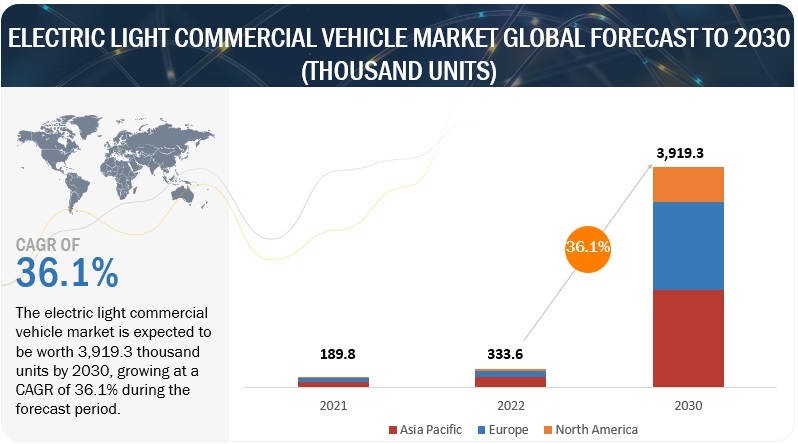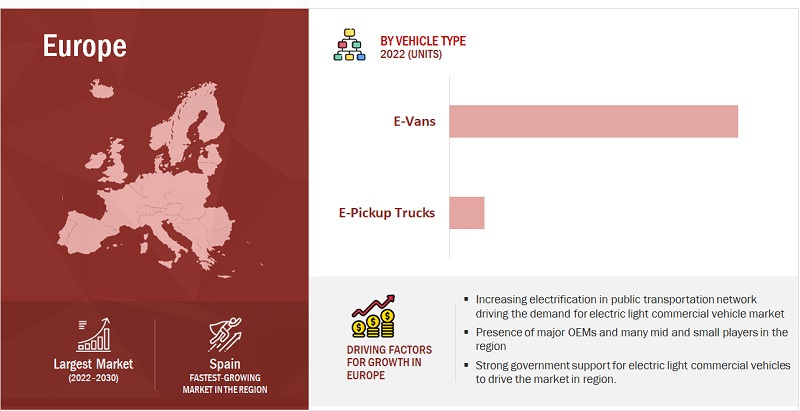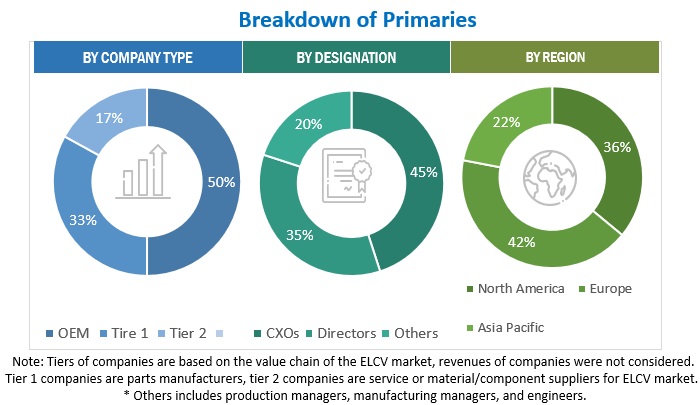Electric Light Commercial Vehicle Market by Propulsion (BEVs & FCEVs), Vehicle Type (E-Pickup Trucks, & E-Vans), and Region (North America, Asia Pacific, Europe) - Global Forecast 2030
[53 Pages Report] The global electric light commercial vehicle market size is projected to grow from 333.6 thousand units in 2022 to 3,919.3 thousand units by 2030, at a CAGR of 36.1%. Factors such as rising demand for low-emission commuting and government subsidies and tax breaks for zero-emission commercial vehicles such as pickup trucks, and vans have driven manufacturers to produce ELCVs for the global market. Also, The growth of e-commerce is also driving the demand for eLCVs, as more and more businesses are using them to deliver goods to customers. For instance, Amazon is using eLCVs to deliver packages to customers in major cities around the world. The development of new charging technologies, such as fast charging and ultra-fast charging, is also increasing the range of eLCVs. This is making eLCVs more suitable for a wider range of applications, such as long-haul delivery. Additionally, Due to the growing demand for electric public transportation and logistics services, the Asia Pacific market is expected to rise steadily. Meanwhile, electric van sales will dominate the European ELCVs market, with major countries expecting to go all-electric by 2030-2035. Furthermore, the North American ELCVs market will expand in tandem with the region's electric pickup sales.

To know about the assumptions considered for the study, Request for Free Sample Report

To know about the assumptions considered for the study, download the pdf brochure
Market Dynamics:
Driver: Reducing prices of ELCVs batteries will increase demand for ELCVs by making them cost effective
The cost of ELCVs batteries has decreased over the last decade as a result of technology improvements and mass production of ELCVs batteries on a huge scale. This has resulted in lower electric light commercial vehicle prices, as EV batteries are one of the most expensive components of an electric vehicle. Prices for ELCVs batteries have dropped dramatically over the previous decade, from USD 1,200/kWh in 2010 to USD 160/kWh in 2023, and are likely to fall further in the future years. Meanwhile, in China, the price per kWh might be as low as USD 100. This is due to lower manufacturing costs for these batteries, lower cathode material prices, increased output, and so on. The prices of ELCVs batteries are predicted to decline to in the upcoming years, considerably lowering the prices of ELCVs and making them cheaper than conventional ICE vehicles.
Restraint: Limited EV charging infrastructure
There are few electric vehicle charging facilities in various countries throughout the world. As a result, the availability of public EV charging for electric vehicles decreases, lowering demand. Although several countries are in the process of establishing EV charging infrastructure, most countries have not been able to install the needed number of EV charging stations, with the exception of a few states. Demand for ELCVs is likely to rise once the world has a well-developed EV charging network. The majority of countries have yet set up such charging networks. The Netherlands has the highest density of EV chargers per 100 km. China comes in second, with approximately 3- 4 charging stations every 100 kilometers. The UK has approximately 3 charge outlets per 100 km, however the government is rapidly expanding its charging stations as part of its 2030 ambitions to phase out ICE vehicle sales. Other countries, like Germany, the United Arab Emirates, Japan, Singapore, South Korea, Sweden, France, the United States, and Russia, have accelerated the transition to EVs by installing a high number of EV charging stations.
Opportunity: Development of wireless EV charging technology for on-the-go charging to fuel market
Wireless charging technology for on-the-go charging has been in development for several years. When this technology matures, individuals will no longer need to charge their vehicles because they will charge themselves while in use. This technology is now prohibitively expensive, but it has the potential to be useful in the next decades. It is projected to have a big impact on the EV market because sales are expected to expand rapidly when this technology is used. Wireless EV charging will be available for stationary charging in 2022. In Norway, a trial of wireless on-the-go EV charging is underway, with the goal of catering to a 25-strong fleet of Jaguar I-pace taxis in Oslo and enabling charging. Further, Siemens and MAHLE announced in August 2022 that they would build a wireless inductive charging system that would wirelessly transfer electricity from an on-ground transmitter to a receiver installed under an EV.
Challenge: Lower availability of lithium for use in ELCVs batteries
Lithium and lithium-ion batteries are experiencing major shortages with the growth in ELCVs demand. The shortfall could lead to higher prices for lithium-ion batteries, which could make ELCVs and other lithium-ion battery-powered devices more expensive. It could also lead to shortages of lithium-ion batteries, which could delay the transition to a clean energy future. While top ELCVs manufacturers are planning to find other alternatives, and reduce usage of lithium, a viable similar cost option is yet to be found. This will lead to lithium prices rising in the coming decade. OEMs are also developing solid state battery technology, which will use less lithium for use and provide longer range per EV charge. This is a major challenge to the fast growth in ELCVs demand, especially in countries which do not have lithium deposits.
Market Ecosystem

The BEV segment to be the largest segment during the forecast period
A BEV is an electric vehicle that runs entirely on batteries. The vehicle is propelled by a permanent magnet motor that is powered by a battery mounted in the vehicle. BEVS have an average range of 150 to 200 miles, which varies depending on battery type and installation. The overall costs of BEVS are likely to reduce in the near future as battery technology advances and battery prices continue to fall by 2030. Furthermore, because electric motors have significantly fewer moving parts than conventional motors and are far more efficient, their maintenance costs are much lower. As of 2023, the typical range of BEVS is 150 to 250 miles and varies depending on battery type installation. BYD, Ford Motor Company, General Motors, Renault have variants in the BEV ev commercial vehicles segment. In June 2022, Renault launched Master E-Tech Electric, equipped with a lithium-ionbattery of 52 kWh and motor capacity of 92 kW. Such development will drive the BEV segment in the forecast period.
Europe is the prominent market for electric light commercial vehicle during the forecast period.
Europe has stringent emission regulation standards, and governments of these countries are providing huge incentives to promote electric vehicles. As a result, the demand for electric vans market has increased tremendously in the region. The region is home to major manufacturers of electric vans, such as Renault, Iveco, LEVC, and Fiat. Europe has set a goal of reducing 80% of CO2 emissions by 2050, as announced by the European Union, and has created a roadmap. In April 2021, DHL Express purchased 100 E-Ducato electric vans from Fiat to electrify its last mile deliveries in Europe. Moreover, the growing charging infrastructure due to the rising demand for EV fast-charging infrastructure and the increasing prevalence of range anxiety among EV users drive the electric light commercial vehicle market.

Key Market Players
The electric light commercial vehicle market is dominated by established players such as BYD (China), Ford Motor Company (US), General Motors (US) Mercedes-Benz (Germany), and Nissan Motor Co. Ltd. (Japan) and among others. These companies manufacture trains and develop new technologies. These companies have set up R&D facilities and offer best-in-class products to their customers.

Want to explore hidden markets that can drive new revenue in Electric Light Commercial Vehicle Market?
 Scope of the Report
Scope of the Report

Want to explore hidden markets that can drive new revenue in Electric Light Commercial Vehicle Market?

|
Report Metric |
Details |
|
Market size available for years |
2019–2030 |
|
Base year considered |
2022 |
|
Forecast period |
2022-2030 |
|
Forecast units |
Volume (Units) |
|
Segments Covered |
Vehicle Type, Propulsion Type, and Region |
|
Geographies covered |
Asia Pacific, Europe, and North America |
|
Companies Covered |
BYD (China), Ford Motor Company (US), General Motors (US) Mercedes-Benz (Germany), and Nissan Motor Co. Ltd. (Japan) |
This research report categorizes the electric light commercial vehicle market based on vehicle Type, Propulsion Type, and Region.
Based on Vehicle Type:
- E-Pickup Trucks
- E-Vans
Based on Propulsion Type:
- BEV
- FCEV
- Diesel/Gasoline
Based on the region:
-
Asia Pacific
- China
- India
- Japan
- South Korea
-
North America
- Canada
- US
-
Europe
- Austria
- France
- Germany
- The Netherlands
- Norway
- Sweden
- Italy
- Spain
- UK
- Others
Recent Developments
- In May 2022, General Motors announced the sale of Zevo 400 by 2023. It is a mid-sized electric van designed for short and frequent trips and has ADAS features. It also offers a range of 250 miles.
- In July 2022, Toyota Motor Corporation announced a partnership with Suzuki Motor Corporation, Daihatsu Motor Co., and Commercial Japan Partnership Technologies (CJPT) to build mini commercial electric vans.
- In June 2022, Renualt launched Master E-Tech Electric, equipped with a lithium-ion battery of 52 kWh and a motor capacity of 92 kW. It also offers a range of 126 miles.
- In June 2022, General Motors announced the supply of 150 Zevo 600 electric vans to FedEx out of 2,500 ordered Zevo 600 electric vans for delivery purposes.
- In March 2022, BYD and Shell announced the improvement of charging infrastructure for BEV and plug-in hybrid electric vehicle (PHEV) owners in China and Europe. The agreement will allow members access to 275,000 charging points through the Shell network.
Frequently Asked Questions (FAQ):
What is the current size of the electric light commercial vehicle market by volume?
The current size of the electric light commercial vehicle market is estimated at 333.6 thousand units in 2022.
Who are the winners in the electric light commercial vehicle market?
The electric light commercial vehicle market is dominated by BYD (China), Ford Motor Company (US), General Motors (US) Mercedes-Benz (Germany), and Nissan Motor Co. Ltd. (Japan), and among others. These companies manufacture trains and develop new technologies. These companies have set up R&D facilities and offer best-in-class products to their customers.
Which region will have the fastest-growing market for electric light commercial vehicle market?
North America will be the fastest-growing electric light commercial vehicle market region due to the increasing awareness of environmental sustainability, and supportive government initiatives.
What are the new market trends impacting the growth of the electric light commercial vehicle market?
EV battery price reductions, connencted vehicles, battery management system, wireless on the go charging are the key market trends or technologies which will have a major impact on the electric light commercial vehicle market in the future.
What are different countries covered in Asia Pacific region for electric light commercial vehicle market?
The countries covered in report for electric light commercial vehicle market are China, Japan, India, South Korea.
To speak to our analyst for a discussion on the above findings, click Speak to Analyst

The study involved four major activities in estimating the current size of the electric light commercial vehicle market. Exhaustive secondary research was done to collect information on the market, the peer market, and the child markets. The next step was to validate these findings, assumptions, and sizing with the industry experts across value chains through primary research. The top-down and bottom-up approaches were employed to estimate the complete market size. Thereafter, market breakdown and data triangulation processes were used to estimate the market size of segments and subsegments.
Secondary Research
In the secondary research process, various secondary sources were used to identify and collect information for this study. The secondary sources include annual reports, press releases, and investor presentations of companies; whitepapers, certified publications; articles from recognized authors, directories, and databases; and articles from recognized associations and government publishing sources. Secondary research has been used to obtain key information about the industry’s value chain, the overall pool of key players, market classification and segmentation according to industry trends to the bottom-most level, regional markets, and key developments from the market- and technology-oriented perspectives.
Primary Research
Extensive primary research has been conducted after acquiring an understanding of this market scenario through secondary research. Several primary interviews have been conducted with market experts from the demand- and supply-side OEMs (in terms of component supply, country-level government associations, and trade associations) and component manufacturers across four major regions, namely, Asia Pacific, Europe and North America. Approximately 23% and 77% of primary interviews have been conducted from the demand and supply side, respectively. Primary data has been collected through questionnaires, emails, LinkedIn, and telephonic interviews. In the canvassing of primaries, we have strived to cover various departments within organizations, such as sales, operations, and administration, to provide a holistic viewpoint in our report.
After interacting with industry experts, we conducted brief sessions with highly experienced independent consultants to reinforce the findings from our primaries. This, along with the in-house subject matter experts’ opinions, has led us to the findings as described in the remainder of this report. Following is the breakdown of primary respondents.

To know about the assumptions considered for the study, download the pdf brochure
Market Size Estimation
The bottom-up approach was used to estimate and validate the total market size. This method was also used extensively to estimate the size of various subsegments in the market.
The research methodology used to estimate the market size includes the following:
- The key players in the industry and markets have been identified through extensive secondary research
- The industry’s supply chain and market size, in terms of value, have been determined through primary and secondary research processes
- All percentage shares, splits, and breakdowns have been determined using secondary sources and verified through primary sources
Global Electric Light Commercial Vehicle Market Size: Bottom-Up Approach

To know about the assumptions considered for the study, Request for Free Sample Report
Data Triangulation
After arriving at the overall market size—using the market size estimation processes as explained above—the market was split into several segments and subsegments. To complete the overall market engineering process and arrive at the exact statistics of each market segment and subsegment, data triangulation and market breakdown procedures were employed, wherever applicable. The data was triangulated by studying various factors and trends from both the demand and supply sides.
Market Definition
Electric LCVs are designed to carry a weight of upto 6 ton. However, they have lower power output than conventional LCVs. Light vans are majorly used in logistics and last mile delivery as their operating cost is low. According to the Sustainable Energy Authority of Ireland (SEAI), a Battery Electric Vehicle or BEV is a vehicle that uses a battery as the sole means of energy storage for the propulsion of the vehicle. A BEV does not have a fossil fuel engine or generator. It is driven purely by an electric motor with battery energy storage.
List of Key Stakeholders
- Associations, Forums, and Alliances related to ELCVs
- Automobile Manufacturers
- Automotive Component Manufacturers
- Automotive Investors
- Automotive Software Manufacturers and Providers
- Battery Distributors
- Battery Manufacturers
- Charging Infrastructure Providers
- Charging Service Providers
- Companies Operating in Autonomous Vehicle Ecosystem
- Distributors and Retailers
- Electric Pickup Truck Manufacturers
- Electric Van Manufacturers
- EV Battery Manufacturers
- EV Charging Equipment Manufacturers
- EV Charging Infrastructure Service Providers
- EV Component Manufacturers
- EV Distributors and Retailers
- Government Agencies and Policy Makers
- Original Equipment Manufacturers
- Raw Material Suppliers for Automotive Software or Components
- Transport Authorities
- Technology Providers
- Vehicle Electronics Manufacturers
Report Objectives
- To define, describe, and forecast the size of the electric light commercial vehicle market in terms of volume (units).
- To define, describe, and forecast the size of the electric light commercial vehicle market based on propulsion type (BEV, and FCEV)
- To segment and forecast the market size by vehicle type (E-Pickup Trucks and E-Vans)
- To segment and forecast the market size, by region (Asia Pacific, Europe, and North America,)
- To understand the market dynamics (drivers, restraints, opportunities, and challenges) of the electric light commercial vehicle market
- To understand the dynamics of competitors in the electric light commercial vehicle market and distinguish them into visionary leaders, innovators, emerging companies, and dynamic differentiators according to their product portfolio strength and business strategies
- To analyze opportunities for stakeholders and the competitive landscape for market leaders
- To strategically profile key players and comprehensively analyze their market share and core competencies
- To track and analyze competitive developments, such as new product launches, deals, and other developments by key players
- To analyze the opportunities offered by various segments of the market to its stakeholders
- To analyze and forecast the trends and orientation for the electric light commercial vehicle market in the global industry
Available Customizations
With the given market data, MarketsandMarkets offers customizations in accordance with company-specific needs.
- Electric Light Commercial Vehicle Market, By Range Type, at the country level (For countries covered in the report)
- Electric Light Commercial Vehicle Market, By Battery Type, at the country level (At Regional Level)
- Profiling of Additional Market Players (Up to 5)














Growth opportunities and latent adjacency in Electric Light Commercial Vehicle Market